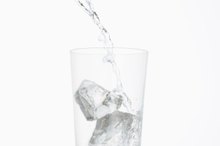What Toxic Chemicals Are in Rubbing Alcohol?
People commonly use rubbing alcohol as a disinfectant for minor cuts and scrapes 5. The two most common forms of rubbing alcohol are ethyl alcohol and isopropyl alcohol 5. Both types are extremely toxic in their concentrated forms. Because most alcoholic drinks contain ethanol, rubbing alcohol made from ethanol usually contains additives such as sucrose octaacetate and denatonium benzoate to prevent people from drinking the alcohol for pleasure 345.
Isopropyl Alcohol Toxicity
The approximate lethal dose of 90 to 100 percent isopropanol for human adults is only 250 millilters or about 8 ounces. While not fatal, ingesting smaller amounts can cause:
- gastrointestinal problems
- including cramps
- pain
- vomiting
- diarrhea
Additionally, isopropanol vapors can irritate the eyes and splashes to the eyes can even burn your corneas.
Ethyl Alcohol Toxicity
Glycerine Vs. Glycol
Learn More
Ethyl alcohol, also called ethanol, is toxic in many of the same ways as isopropyl alcohol. Ethanol causes severe irritation of the eyes accompanied by extreme sensitivity to light. If used excessively as rubbing alcohol, it can cause irritation and redness of the skin 5. It may even cause cyanosis, which is a condition characterized by a blue coloration of the skin, in your extremities.
Ingestion of ethanol causes nausea, diarrhea and vomiting. The system-wide toxicity that results from ethanol ingestion can cause acidosis of the blood and central nervous system depression characterized by excitement, followed by dizziness, drowsiness and nausea. This is the feeling of 'drunkenness' familiar to many people who drink alcoholic beverages.
Consumption of large quantities of ethanol leads eventually to collapse, coma and possibly death by respiratory failure. Chronic ingestion of ethanol causes fetal defects and liver damage. Lastly, inhalation of concentrated ethanol fumes also causes central nervous system effects. Respiratory irritation can be followed by nausea, dizziness, headache, unconsciousness and coma. Inhalation of extreme amounts of ethanol vapors can cause death by suffocation.
- Ethyl alcohol, also called ethanol, is toxic in many of the same ways as isopropyl alcohol.
- The system-wide toxicity that results from ethanol ingestion can cause acidosis of the blood and central nervous system depression characterized by excitement, followed by dizziness, drowsiness and nausea.
Additives
People commonly drink ethyl alcohol to become intoxicated. To prevent people from drinking ethanol-based rubbing alcohol, manufacturers add chemicals to make rubbing alcohol extremely bitter and undrinkable 5. These additives include sucrose octaacetate and denatonium benzoate 34. Neither chemical is toxic; indeed, small quantities of denatonium benzoate can be put on a child's thumb to prevent her from sucking it 4.
Related Articles
References
- Material Safety Data Sheet: Isopropanol
- Material Safety Data Sheet: Ethanol
- Chemical and 21: Sucrose Octaacetate
- Denatonium Benzoate: FAQ
- New Drug Info: Rubbing Alcohol
- National Institute on Alcohol Abuse and Alcoholism. Alcohol Metabolism: An Update. Alcohol Research & Health. 2007;30(1).
- Taylor B, Rehm J. The relationship between alcohol consumption and fatal motor vehicle injury: high risk at low alcohol levels. Alcohol Clin Exp Res. 2012;36(10):1827-34. doi:10.1111/j.1530-0277.2012.01785.x
- Ferré S, O'Brien MC. Alcohol and caffeine: The perfect storm. J Caffeine Res. 2011;1(3):153-162. doi:10.1089/jcr.2011.0017
- Stornetta A, Guidolin V, Balbo S. Alcohol-derived acetaldehyde exposure in the oral cavity. Cancers (Basel). 2018;10(1):20. doi:10.3390/cancers10010020
- Hadland SE, Levy S. Objective testing: Urine and other drug tests. Child Adolesc Psychiatr Clin N Am. 2016;25(3):549-65. doi:10.1016/j.chc.2016.02.005
- Stewart SH, Koch DG, Willner IR, Randall PK, Reuben A. Hair ethyl glucuronide is highly sensitive and specific for detecting moderate-to-heavy drinking in patients with liver disease. Alcohol Alcohol. 2013;48(1):83-7. doi:10.1093/alcalc/ags109
- Fillmore MT, Jude R. Defining "binge" drinking as five drinks per occasion or drinking to a .08% BAC: which is more sensitive to risk? Am J Addict. 2011;20(5):468-75. doi:10.1111/j.1521-0391.2011.00156.x
- American Association for Clinical Chemistry. Ethanol. 2018.
- Cederbaum A. Alcohol metabolism. Clinics in Liver Disease. 2012;16(4):667-685. doi:10.1016/j.cld.2012.08.002
- LabCorp, Inc. Drugs of Abuse Reference Guide. 2007.
- National Institute on Alcohol Abuse and Alcoholism. Alcohol Metabolism: An Update. Alcohol Research & Health. 2007;30(1).
Writer Bio
Timothy Banas has a master's degree in biophysics and was a high school science teacher in Chicago for seven years. He has since been working as a trading systems analyst, standardized test item developer, and freelance writer. As a freelancer, he has written articles on everything from personal finances to computer technology.







